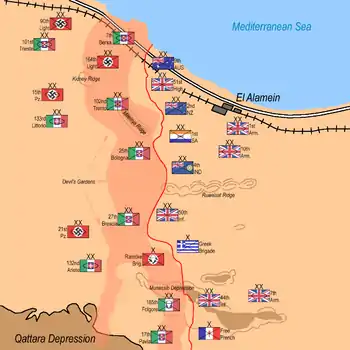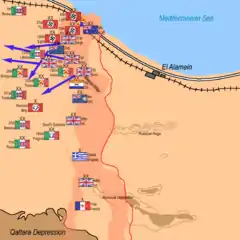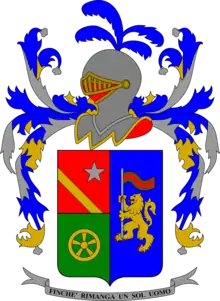102nd Motorised Division Trento
The 102nd Motorised Division Trento (in Italian: 102ª Divisione Fanteria Trento) was a motorised infantry division of the Italian Army during World War II. It was formed in 1939 and kept in reserve in Italy until it was moved to North Africa in February 1941. It took part in Axis attacks across North Africa, following the Allied Operation Compass and suffered heavy losses at Tobruk. The division was then reformed and took part in all of the major battles of the Western Desert Campaign until it was destroyed during the Second Battle of El Alamein.
| 102nd Motorised Division Trento | |
|---|---|
 102a Motorised Division Trento Insignia | |
| Active | 1939–1943 |
| Country | Kingdom of Italy |
| Branch | Royal Italian Army |
| Type | Motorised infantry |
| Size | Division |
| Part of | Italian XXI Corps |
| Nickname(s) | Trento |
| Engagements | Western Desert Campaign |
North Africa
The Trento arrived in North Africa to reinforce the Italian Fifth Army following the Allied offensive Operation Compass,[1] a counterattack by British and Commonwealth troops of the Western Desert Force in response to the Italian invasion of Egypt. The offensive resulted in the destruction of the Italian Tenth Army and the Allied occupation of the Italian province of Cyrenaica.[2]
Siege of Tobruk
The Trento took part in the Axis counterattack of March 1941 that forced the British and Commonwealth forces into retreat.[3] While the Australian 9th Infantry Division fell back to the fortified port of Tobruk,[4] British and other Commonwealth forces withdrew a further 100 miles (160 km) east to Sollum, on the Libyan–Egyptian border.[5] These moves initiated the 240-day-long Siege of Tobruk, in which the Trento was involved.
After the failure of an Axis attack on El Adem Erwin Rommel, the German officer commanding Axis forces in North Africa, decided to attack the western sector of the Australian perimeter at Tobruk on 15 April, around Ras el Madauar. Rommel used the 132ª Divisione corazzata "Ariete" (132nd "Ariete" Armoured Division) along with the 62nd Infantry Regiment (Sicily) (62nd "Sicilia" Infantry Regiment) of the Trento division.[6] The Australian 2/43rd Battalion War Diary reported that "The Italians attacked our 48 Bn and whilst withdrawing [the Italian] were fired upon by German tanks believed to be supporting the attack."[7] The Australians sent out Bren-gun carriers to find and attack the Italian flank. The extra firepower stopped the Italians and firing ceased. Italian casualties were 24 dead, 112 wounded and 436 prisoners, including a colonel, who was furious at having his unit shot up by German tanks that he reportedly cooperated with Allied interrogators.[8] Journalist Chester Wilmott, reporting on an Australian communiqué in the New York Times (17 April 1941) described the actions: "One of our patrols successfully penetrated an enemy position outside the defences of Tobruk capturing 7 Italian officers and 139 men. A further attack on the defences of Tobruk was repulsed by artillery fire. The enemy again suffered heavy casualties. During yesterdays operations a total of 25 officers and 767 of other ranks were captured. In addition over 200 enemy dead were left on the field.[9] A subsequent intelligence assessment by the 2/43rd Battalion concluded that: "Reports from PW indicate that a large-scale attack was to have been launched on the Tobruk defences on or about 16 April 41. There appears to have been no co-ordination between enemy tanks and inf units. The ITALIANS appear to have been somewhat in the dark as to their actual objectives and the method of co-ordination by means of GERMAN liaison officers working with ITALIAN units has not been successful. PW also state that the spasmodic attacks in different sectors between 14 and 16 Apr, sometimes inf alone, sometimes tks alone sometimes both, were all intended to be a simultaneous assault which apparently went badly astray in its timing.[10]
Over the next few weeks, there were a series of minor victories for the Axis. On the night of 30 April, a strong Italo-German force attack the Tobruk defences, and a force including the Ariete, Brescia, 8th Bersaglieri Regiment and XXXII Mixed Engineer Battalion capture seven Australian strongpoints (R2, R3, R4, R5, R6, R7 and R8).[11] When, on the night of 3 May, the Australians counterattack, the Italians in the form of the Trento and Pavia Divisions, repel them.[12] and the attackers are only able to recapture one strongpoint from the defending Italian troops.[13] On the night of 16 May, the Brescia Division attacks with the help of two platoons of the 32nd Combat Engineer Battalion and breaches the defensive perimeter of the Australian 2/9th and 2/10th Battalions. With these obstacles removed, the Brescia troops involved, who bring flame-thrower parties and tanks, capture the S8, S9 and S10 strongpoints.[11] The Australians fight back and the Commanding Officer of the Guastatori, Colonel Emilio Caizzo is killed in a satchel attack and wins a posthumous Gold Medal for valour. Although the Australian Official History admits losing three positions, it claims the attackers were 'Germans'.[14] Australian military historian Mark Johnston states there was an "unwillingness to acknowledge reverses against Italians" in Australian official accounts.[15] An Italian account records: "With great skill and speed the Guastatori open three lanes in the mines and obstacles to let the Brescia Fucilieri through. Side by side with the Brescia assault troops they inflict heavy losses on the enemy and take out further strong points with explosives and flamethrowers."[16]
The Australian commander, Major-General Leslie Morshead is furious at the loss of the strongpoints, and orders the Australians to be far more vigilant in the future.[17] Among the objectives initially selected during the planning of Operation Brevity was the recapture of strongpoints S8 and S9, but this was abandoned under the belief that the Australians had, or would soon, recover them.[18] On 24 May, the Brescia Division which has taken over the western front of Tobruk, repels an attacking infantry force, supported by tanks. On 2 August, an Australian attack is launched to recover the lost strongpoints, but the attacking 2/43rd Battalion and 2/28th Battalions are defeated. The Trento in the form of its 7th Bersaglieri Regiment soon arrives to replace the weary Italian forces defending the captured strongpoints, and the Australians continue to fight hard to recover them. On 2 August, the Australian 2/43rd and 2/28th Battalions, in a final attempt to recover the lost strongpoints, carry out a determined attack, but are repulsed with heavy loss of life.[19] After much fierce fighting, the Bersaglieri troops are finally ordered to move back to Gazala to rest and refit.[20]
Operation Brevity and Battleaxe
The British XIII Corps launched Operation Brevity on 15 May 1941. The objective of the operation was to clear the Halfaya Pass and secure several footholds to create advantageous conditions from which to launch Operation Battleaxe.[21][22]
The principle Axis opposition was Kampfgruppe von Herff, positioned on the desert plateau, which included up to 50 German tanks and the 5th Motorised Infantry Battalion, Trento, as well as supporting arms. The front line area around Halfaya Pass was defended by two companies of Bersaglieri with artillery support.[23][24]
After a day of inconclusive fighting the operation was abandoned and British forces took control of the pass. Total Italian casualties during the operation are unknown, though at least 347 men were taken prisoner during the operation.[25][26] On 5 August 1941, Colonel von Herff praised the Bersaglieri, who he said had defended Halfaya Pass "...with lionlike courage until the last man against stronger enemy forces. The greatest part of them died faithful to the flag."[27]
The division next saw action during the Allied attack codenamed Operation Battleaxe in mid-June 1941. The division was deployed forward with three infantry battalions and one artillery regiment stationed in the Sollum-Musaid-Capuzzo area. The rest of the division was located at Bardia.[28]
Operation Crusader
Operation Crusader was launched by the British Eighth Army between 18 November–30 December 1941, with the objective of relieving the siege of Tobruk. Trento was now part of the Italian XXI Corps with the 17 Infantry Division Pavia, the 25 Infantry Division Bologna, and the 27 Infantry Division Brescia.[29] The attacks of the British 70th Division were checked for a time by the Trento, but the attackers were able to lift the siege of Tobruk on 10 December.
Battle of Gazala

The Battle of Gazala was fought May–June 1942. The plan was for the armoured and motorised divisions to perform a right flanking attack while the Italian XXI Corps and the Italian X Corps, which included the Trento, would advance parallel to the coast road.[30][31] The Trento played an important role in the capture of 6,000 prisoners at Gazala on June 16.[32]
Battle of Mersa Matruh
During the Battle of Mersa Matruh on 26–30 June 1942, Trento, with the 46th Artillery and 7th Bersaglieri Regiments attached, played an important part in the capture of 6000 defenders of the Xth British Corps, along with large quantities of supplies.[33]
First Battle of El Alamein
During the First Battle of El Alamein, elements of the Trento put up a tenacious defense on Miteiriya Ridge, delaying the Allied advance for several hours and allowing an Italian armoured reconnaissance force to launch a devastating counterattack.[34]
Second Battle of El Alamein


Before the start of the Second Battle of El Alamein the Trento was positioned along the Miteirya Ridge. On 24 October they came under attack from the 2nd New Zealand Division supported by 10th Armoured Division. By 25 October the Allies had broken through the minefields and were positioned on top of the Miteiriya Ridge. Italian casualties from incessant artillery and air attack had been heavy, particularly in the north. The Trento had lost half its infantry and most of its artillery.[35] According to author Walter S. Zapotoczny (a graduate of the U.S. Army Sergeant Majors' Academy), the 61st and 62nd Infantry Regiments of the Trento Division had fought well, including the anti-tanks gunners of Captain Vigano and engineers of Colonel Randi that were attached to the division.[36] On 2 November Rommel ordered the X and XXI Italian Corps and 90th Light Afrika Division to stand firm while the Afrika Korps would withdraw approximately six miles west during the night of 3 November, with XX Italian Corps and the Ariete Division conforming to their position.[37]
Order of battle

- 61st Infantry Regiment "Sicilia"
- 62nd Infantry Regiment "Sicilia"
- 7th Bersaglieri Regiment
- 46th Artillery Regiment (mot)
- 51st Engineer Battalion
- 161st Mining Company
- 51st Medical Section
- 22nd Motor Transport Section
- 297th Motor Transport Section
- 9th Mixed Motor Transport Section
- 37th Heavy Motor Transport Section
- 68th Field Bakery
- 160th Carabinieri Section
- 180th Carabinieri Section
- 266th Carabinieri Section
- 109th Field Post Office [38][nb 1]
Notes
- Footnotes
- An Italian Infantry Division normally consisted of two Infantry Regiments (three Battalions each), an Artillery Regiment, a Mortar Battalion (two companies), an Anti Tank Company, a Blackshirt Legion (Regiment of two Battalions). Each Division had only about 7,000 men, The Infantry and Artillery Regiments contained 1,650 men, the Blackshirt Legion 1,200, each company 150 men.[39]
- Citations
- Bauer, p.121
- Playfair (1954), pp. 362 – 366, 371 – 376
- Playfair (1956), pp. 19–40
- Latimer, pp. 43–45
- Playfair (1956), pp. 33–35
- Playfair (1956), p. 38
- "Appendix No. 30:(Unreadable) Summary No. 2, entry for 16 Apl" (PDF). 2/43 Infantry Battalion War Diary, April 1941. Australian War Memorial. Retrieved 2008-06-10.
- Tobruk 1941: Capture-Siege-Relief, p.564, Chester Wilmot, Angus and Robertson Ltd, 1944
- "The Text of the Day's Communiques on Fighting in Europe and Africa: British". New York Times (18 April 1941). Archived from the original on 27 April 2009. Retrieved 2008-04-12.
- "Appendix No. 31: Bash Intelligence Summary No. 3. General" (PDF). 2/43 Infantry Battalion War Diary, April 1941. Australian War Memorial. Retrieved 2008-06-10.
- XXXII BATTAGLIONE GUASTATORI
- The Forgotten Axis: Germany's Partners and Foreign Volunteers in World War II, J. Lee Ready, p. 310, McFarland & Co., 1987
- That magnificent 9th: An Illustrated History of The 9th Australian Division, Mark Johnston, p. 38, Allen and Unwin, 2002
- Maughan (1966), p.250
- Fighting the Enemy: Australian soldiers and their adversaries in World War II, Mark Johnston, p. 13, Cambridge University Press, 2002
- GUASTATORI IN NORTH AFRICA. The XXXI and XXXII Guastatori Battalions in the North African Campaign
- Maughan (1966), p.251
- Tobruk 1941, The Desert Siege, Timothy Hall, p. 183, Methuen Australia, 1984
- North Africa 1941–1942 Second AIF Veterans Support and Advocacy Service Australia Inc.
- (in Italian). Associazione Bersaglieri della Regione. I Bersaglieri website.
- Chant, p. 21
- Playfair (1956), pp. 159–160
- Playfair (1956), p. 160
- Jentz, pp. 128–129
- Erskine, p. 79"
- Hastings, p. 70
- New York Times article, Italians' Bravery Praised By Nazi Chief in Africa. 5 August 1941
- Playfair (1960), p. 164
- Clifford, p. 123
- Playfair (1960), p. 223
- Mackenzie, p.541
- The Rise of the Wehrmacht: The German Armed Forces and World War, 2 Volumes, p.564, Samuel W. Mitcham, Praeger (June 30, 2008)
- Aldea, David. "Mersa Matruh". Commando Supremo: Italy at War website. Retrieved 2019-04-28.
- Aldea, David. "First Battle of El Alamein". Commando Supremo: Italy at War website. Retrieved 2019-04-28.
- Playfair (1966), P. 50
- "Italy's North African Misadventure. By Walter S. Zapotoczny" (PDF). Archived from the original (PDF) on 2011-07-24. Retrieved 2011-06-11.
- Playfair (1966), p. 73.
- Wendal, Marcus. "Italian Army". Axis History. Archived from the original on 2009-04-27. Retrieved 2009-07-04.
- Paoletti, p 170
References
- Bauer, Eddy; Young, Peter (general editor) (2000) [1979]. The History of World War II (Revised ed.). London, UK: Orbis Publishing. ISBN 1-85605-552-3.
- Chant, Christopher (1986). The Encyclopedia of Code Names of World War II. London: Routledge & Kegan Paul. ISBN 0-7102-0718-2.
- Erskine, David (2001) [1956]. The Scots Guards 1919–1955. Naval & Military Press. ISBN 1-84342-061-9.
- Hastings, R.H.W.S. (1950). The Rifle Brigade in the Second World War 1939–1945. Aldershot, UK: Gale & Polden. OCLC 6190324.
- Jentz, Thomas L. (1998). Tank Combat in North Africa: The Opening Rounds, Operations Sonnenblume, Brevity, Skorpion and Battleaxe, February 1941 – June 1941. Schiffer Publishing. ISBN 0-7643-0226-4.
- Mackenzie, Compton (1951). Eastern Epic: September 1939 – March 1943 Defence. I. London: Chatto & Windus. OCLC 59637091.
- Paoletti, Ciro (2008). A Military History of Italy. Greenwood Publishing Group. ISBN 0-275-98505-9.
- Playfair, Major-General I.S.O.; with Flynn R.N., Captain F.C.; Molony, Brigadier C.J.C. & Toomer, Air Vice-Marshal S.E. (2004) [1st. pub. HMSO 1956]. Butler, J.R.M (ed.). The Mediterranean and Middle East, Volume II The Germans come to the help of their Ally (1941). History of the Second World War, United Kingdom Military Series. Naval & Military Press. ISBN 1-84574-066-1.
- Playfair, Major-General I.S.O.; with Flynn R.N., Captain F.C.; Molony, Brigadier C.J.C. & Gleave, Group Captain T.P. (2004) [1st. pub. HMSO 1960]. Butler, J.R.M (ed.). The Mediterranean and Middle East, Volume III: British Fortunes reach their Lowest Ebb (September 1941 to September 1942). History of the Second World War United Kingdom Military Series. Naval & Military Press. ISBN 1-84574-067-X.
- Playfair, Major-General I.S.O.; Molony, Brigadier C.J.C.; with Flynn R.N., Captain F.C. & Gleave, Group Captain T.P. (2004) [1st. pub. HMSO 1966]. Butler, J.R.M (ed.). The Mediterranean and Middle East, Volume IV: The Destruction of the Axis Forces in Africa. History of the Second World War United Kingdom Military Series. Uckfield, UK: Naval & Military Press. ISBN 1-84574-068-8.